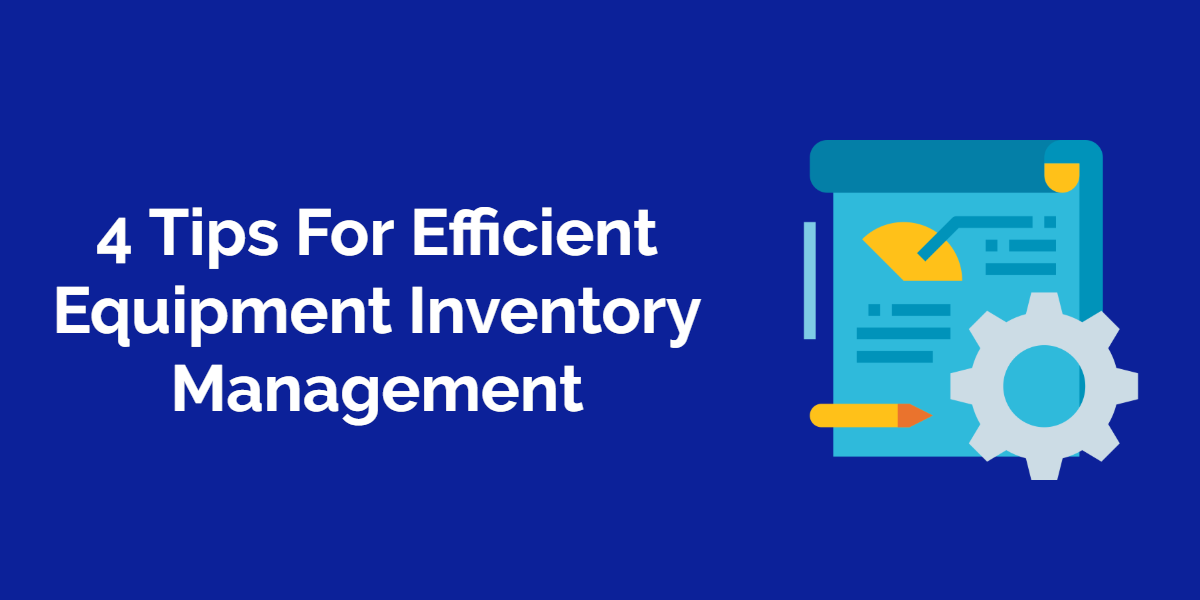Why is equipment inventory management important?
Whichever sector it operates in, a business must follow adequate equipment inventory management practices. Lack of proper inventory management can lead to unexpected outages and project delays.
Adding to this, you cannot run the risk of using faulty or hazardous equipment at a project site. It can cause injuries and slow down your daily operations even further.
Halted workflows are both costly and time-consuming. They not only strain your financial and human resources but also slow down customer delivery. This results in a tarnished brand image.
Therefore, it is important to avoid such roadblocks in your daily operations by keeping a check on your equipment inventory levels. A well-grounded equipment inventory management strategy is key to ensuring that your business runs without a hitch.
Efficient equipment inventory management also improves the effectiveness and life of your assets equipment thereby saving precious resources like money and time. Lack of proper equipment tracking leads to huge losses due to the complexity of monitoring each piece of equipment manually.
Here are some challenges you are likely to face if you do not invest in a robust equipment inventory management system.
1. Expired equipment warranty
Whenever you purchase a new piece of equipment, you typically get a warranty agreement from the manufacturer as well. This specifies a duration during which you can get your tools inspected and fixed or replaced free of cost.
Without an inventory system to keep tabs on equipment warranties, you may have to pay extra maintenance charges after the warranty expires. An inadequate inspection routine often requires you to dispose of the equipment prematurely too.
2. Accumulation of dead stock

Deadstock refers to items that businesses store but no longer use. Without proper equipment inventory management in place, businesses tend to hoard lots of dead stock.
It simply ties up your financial resources and takes up unnecessary storage space, without adding any value to sales.
3. Lack of standardization
Tools that carry out a similar function or have similar properties call for a standardized management procedure. Doing so lets you understand how each tool works and how you can get the best out of it.
An absence of accurate inventory records means you are unfamiliar with assets that have identical properties. Classification of assets becomes hard and businesses struggle with devising standardized management strategies.
4. Unexpected equipment downtime
Perhaps the biggest risk associated with equipment failures and operational complexity is the loss of time. Equipment failures cause delays and can sometimes also halt operations entirely. This amounts to huge financial and opportunity costs that the business has to bear itself.
As a solution to this issue, businesses should streamline equipment and asset management to track critical assets and save the time spent on maintaining and repairing them individually.
Read more: 4 Common Causes of Equipment Failure and Best Practices to Prevent it
What are the basics of a good equipment inventory management strategy?
For a successful equipment inventory management, organizations should take stock of some key tracking routines. These generally vary across industries.
However, you can even customize them based on your company’s workflows and management needs.
Let’s take a look at some universal equipment management practices that help maximize productivity levels.
1. Barcode tracking

The fastest, simplest and most widely used equipment management system is that of barcode tracking. It involves developing a unique identification number for each piece of equipment.
You can then read these codes using a handheld scanner or a smartphone device to track asset utilization. For standardization purposes, businesses often generate barcodes in line with the Universal Product Codes (UPCs).
UPCs are affixed to a product by the manufacturer. UPCs are different from Stock Keeping Units (SKUs). They refer to identification numbers assigned by a business for internal tracking or stock keeping.
Therefore, barcodes for two identical products can have the same UPC but different SKUs.
Read more: How to Make the Best Use of a Barcode Asset Management System
2. Location management
Equipment and tools tend to change locations quite often. They are likely to get misplaced if not monitored properly. Thus, it is crucial to keep tabs on asset movements.
Most businesses manage their equipment inventory by location tracking. GPS tags help a great deal in this regard. They notify you when an asset is checked into or out of a location.
You can even streamline your warehousing with location management. You can assign IDs to each warehouse and nest sub-locations such as aisles and shelves under each warehouse to make the process more precise.
This makes it easier to locate equipment and spot check for theft if it ever goes missing.
3. Quality control
Most businesses use equipment inventory management to ensure compliance with regulatory standards too. A rock solid inventory system lets you schedule inspection routines and service sessions.
This cuts down on instances of unforeseeable equipment breakdown. By keeping the performance of your equipment under constant scrutiny, you ensure quality control.
Regular servicing also keeps equipment safety concerns at bay.
4. Scheduling maintenance and service
Spending money on asset acquisition and maintenance is a major chunk of a business’ annual budget. Decisions such as spending money to acquire new capital equipment require updated and streamlined asset data across the company as they affect the bottom-line.
In order to do this, strategies should be aligned according to the life span of these assets, otherwise a small mistake could trigger a trickle-down effect of a multitude of problems for the stakeholders. In this way, capital budgeting is an important strategy for businesses across the globe and requires accurate data as major decisions rely on it.
It is important for the management to be fully aware of the costs and accumulated depreciation per asset to ensure optimum productivity.
How to run effective equipment inventory management
A dedicated inventory management strategy means your stock levels are updated at all times. You have access to real-time inventory information and can make sales decisions accordingly.
However, it is important to devise your equipment inventory management strategy in a way that brings you the maximum return.
Here are some best practices you can follow to get the most bang for your buck invested in an inventory tracking system.
1. Maintain a consolidated asset database

With a robust equipment inventory management system in place, you can log crucial data regarding all your equipment. Inventory software, if paired with a barcode tracking solution, lets you clock in asset details with a single barcode scan.
The system houses all relevant equipment details in a cloud database that you can access from anywhere, at anytime. You can monitor any updates in the status, usage and location of equipment in real time.
An exhaustive asset database also helps flag any ghost assets by tracking utilization patterns over the years.
2. Track equipment utilization
Once you have an exhaustive list of all your assets, you need to keep an eye on utilization of your equipment. It helps greatly with procurement decisions. A rule of thumb is to procure more of what you use more.
You can even glean over insights regarding which departments use which tools the most. This helps iron out the asset checkout process. You can group together equipment that is specific for use by a department and check it out in bulk.
Equipment utilization patterns zero in on assets that bring you the highest returns so you can continuously invest to increase your ROIs.
3. Automate procurement cycles
Planning out an inventory purchase routine can get quite hectic. With their hands almost full, it is possible for managers to lose track of declining stock levels.
To make things simpler, you can automate procurement cycles using an equipment management system. You can set minimum threshold levels for each of your equipment.
Whenever your stock reaches this threshold, the system automatically generates Purchase Orders. It notifies the vendors and replenishes your stock before you run out of it.
This practice also prevents overstocking and saves you exorbitant storage costs. This type of strategic sourcing also comes in handy when it comes to managing perishable or delicate, high ticket goods.
4. Schedule maintenance events
Organizations that house a wide array of equipment inventory must take stock of regular maintenance. Storing obsolete and faulty equipment does absolutely no good and adds no value to your business.
Thus, you must ensure that the inventory management system schedules all your assets for periodic repairs. Most inventory systems come saddled with a Maintenance module.
This module lets you initiate recurring services and service triage as well. This way whenever an asset is checked in after use, the system first checks it out for service.
Hence, this practice guarantees that all assets used by your employees are in top shape. Timely maintenance truncates replacement and repair costs. It also helps improve productivity levels.
A dedicated equipment inventory management system helps devise risk management strategies
When used the right way, inventory software lets you automate business tasks and offers access to vital asset information.
You can even utilize equipment inventory management software to run performance reports for your business. Reports give you a bird’s eye view of your operations.
They also highlight threatening instances where your equipment is performing low. This way you can devise risk management strategies and protect your business before it takes a dip.
Get a thorough understanding of your supply chain with equipment inventory management and do away with unforeseen setbacks.
Read more:Equipment Inventory Software: Features And Best Practices
About EZOfficeInventory
EZOfficeInventory is the leading equipment inventory management system. It allows you to track, maintain and report on equipment from anywhere, at any time.







